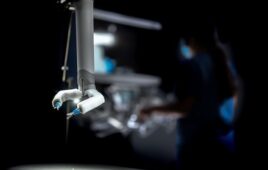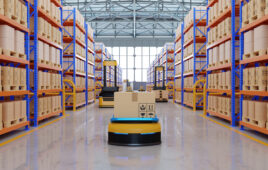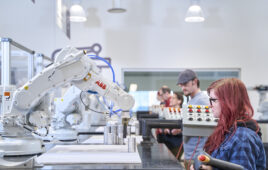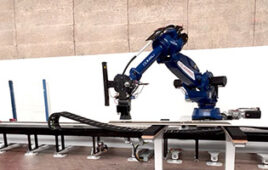Kässbohrer PistenBully snow groomers are now being painted by Dürr robots to save labor and cut the process time in half. The manufacturer of specialized vehicles for slope preparation has automated the process to gain better efficiency in production and expose workers to less paint fumes and solvents.
The surfaces of the PistenBully cabs are exposed to extreme conditions and harsh environments, such as sharp ice crystals to temps below freezing, and even strong UV radiation. In order to provide protection against these environments, two primer coats and a base coat are applied by the EcoRP L033 painting robot. The bot coats the metal frames from the outside and inside.
“The most time the robot needs to paint a cab is an hour. Compared to previous painting by hand, this saves us so much time that we’ve been able to significantly increase our output to 600 cabs per year,” says Uwe Thierer, Plant Manager at Kässbohrer Geländefahrzeug AG’s Laupheim site.
Speed and quality ignite the autonomous process, ensuring all results are uniform.
The paint layers are applied in a combination booth, where EcoRP L033 first applies two primer layers as a bonding agent and corrosion protection wet-in-wet without drying in between. The color changing and dosing technology integrated within the front robot arm allows minimal paint loss when changing color, as well as short rinsing times with less solvent consumption. Following this process is the intermediate drying stage, and finally the base coat color application stage.
Dürr’s scope of delivery also includes the skid conveyor technology with turntable and tilt function. This ensures reproducible cab adjustment and correct positioning of the cab for the painting process. The robot then paints the cab body with the two primer layers, which looks after the corrosion protection and takes place in the tank. Five pressure pots for main color, hardener, and thinner are provided for the paint supply.
This automated process mitigates the harsh environments that workers are exposed to and has allowed the company to increase their rate of work exponentially. In addition to automating this process, Kässbohrer has also switched to chromate-free paint for the PistenBully manufacturing process. Check out the painting robot in action.
Filed Under: Product design, Robotics • robotic grippers • end effectors




